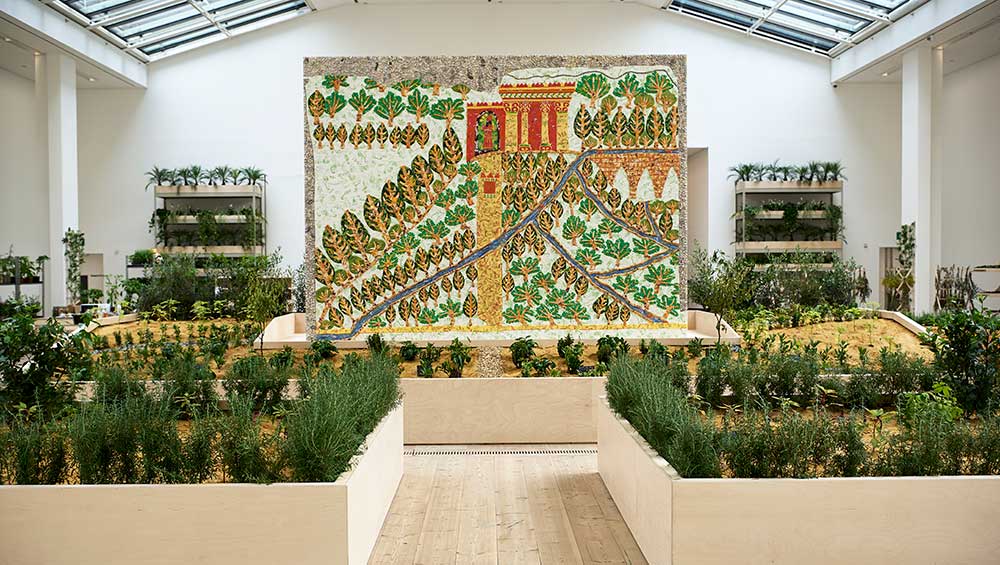
Michael Rakowitz: The Waiting Gardens of the North, an IWM 14-18 NOW Legacy Fund commission in partnership with Baltic Centre for Contemporary Art. Photo: John McKenzie. © 2023 Baltic.
Baltic Centre for Contemporary Art, Gateshead
15 July 2023 – 26 May 2024
by VERONICA SIMPSON
Winding my way on foot to the fifth floor (the lifts are busy on my visit) of Baltic’s enormous post-industrial art space on the banks of the Tyne, it is just as well that the sight of Michael Rakowitz’s The Waiting Gardens of the North is one to refresh and uplift the senses – sight and smell in particular. On a warm August day, the sun pours down through newly reopened rooflights on to sand and planters laid out in carefully choreographed rows and arcs across the room, activating the scents of the rosemary, bay, basil, olive and amaranth plants inhabiting the sand- and loam-filled beds.
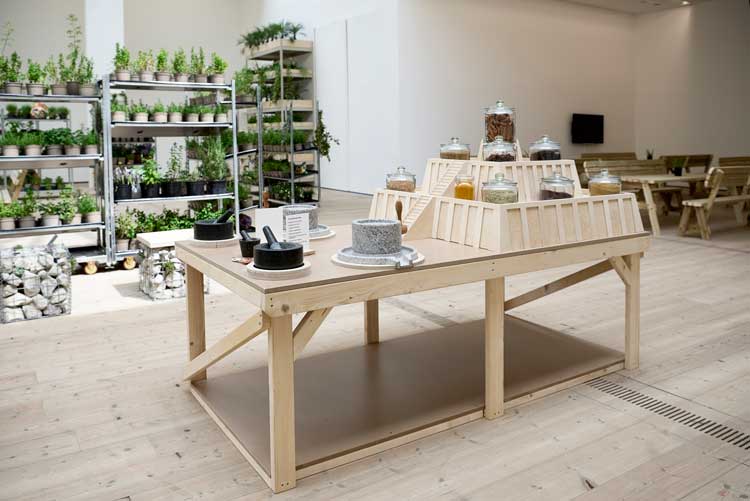
Michael Rakowitz: The Waiting Gardens of the North, an IWM 14-18 NOW Legacy Fund commission in partnership with Baltic Centre for Contemporary Art. Photo: John McKenzie. © 2023 Baltic.
A sense of welcome was very much in Rakowitz’s mind as he planned this commission. The Chicago-based Iraqi American artist (b1973, New York) took his inspiration from the Hanging Gardens of Babylon, which were built, according to legend, by King Nebuchadnezzar (ruled 605-562 BC) to comfort his homesick wife, Amytis, and planted with trees, shrubs and herbs that reminded her of home. However, the academic Stephanie Dalley, after studying the original cuneiform texts, thinks the Hanging Gardens of myth were built in Nineveh, 300 miles away, and planted by the Assyrian King Sennacherib a century before. Rakowitz blends the spirit of the first with the architecture of the second, recreating the Assyrian garden as depicted in a relief panel of the North Palace of Ashurbanipal, with its orchards and groves, irrigation channels and arches. He does so in a large gold, ochre and green sculptural relief that looms large in the centre of the room and in his arrangement of real plants to create a three-dimensional version of that garden. The qualities of welcome and healing for the homesick have also been translated into the selection of plants themselves, as well as a multilayered programme of research, workshops and collaboration that preceded this exhibition and will continue for many months during (and hopefully beyond) its extended duration.
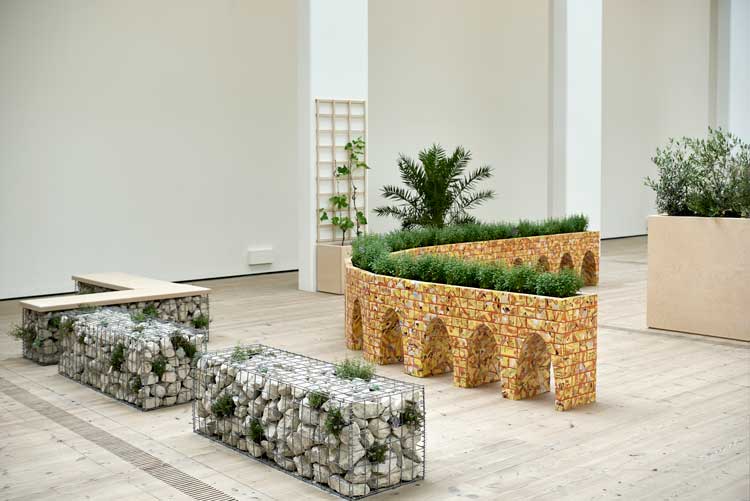
Michael Rakowitz: The Waiting Gardens of the North, an IWM 14-18 NOW Legacy Fund commission in partnership with Baltic Centre for Contemporary Art. Photo: John McKenzie. © 2023 Baltic.
Rakowitz’s art examines the history of colonialism and extraction. He constructs large and small monuments and sculptures evoking items looted via war and land grabs. Most notably, for Trafalgar Square’s fourth plinth (March 2018 - 2020), he reconstructed the figure of a human-headed, winged bull from an Assyrian statue destroyed by Isis. He used metal from Iraqi cans of date syrup to clad the steel armature: a feature of his practice is to reuse everyday items in his reconstruction, mostly packaging and newspapers, that speak of the diasporic communities dispersed by conflict and crisis. He does so here in the sculptural relief, which is made from food packaging sourced from local stores that specialise in south Asian and west African foods. But there is extra symbolism in his working with live plants, significant for his historical research and the plants’ links with the displaced communities of Newcastle (of which more later).
The commission for this work came from the Imperial War Museum 14-18 NOW Legacy Fund, which supports work that explores the impacts of conflict. For Rakowitz, the Waiting Gardens symbolise the agonising suspension of life and citizenship that accompanies forced migration and asylum seeking. From his own research into the plants that would have featured in the Assyrian or Babylonian garden, combined with workshops Baltic conducts on a monthly basis with migrant and refugee communities, in its Language Cafe, a list was compiled of the plants most evocative of these dispersed peoples’ homes - the fruits and vegetables they miss, some of which can be grown here, many of which can’t. Working with live plants has added potency as these fragile beings take time to settle and grow, evoking fragility (not all of them survive) as well as hope and potential. The properties of these living plants have also informed the programme, which sees daily rituals enacted, to which the public are invited, in the form of a spice-grinding workshop at 4pm and tea-drinking rituals at 12 noon. There is also an area dedicated to medicinal herbs, with tinctures that have been made in workshops by visitors and the Baltic staff.
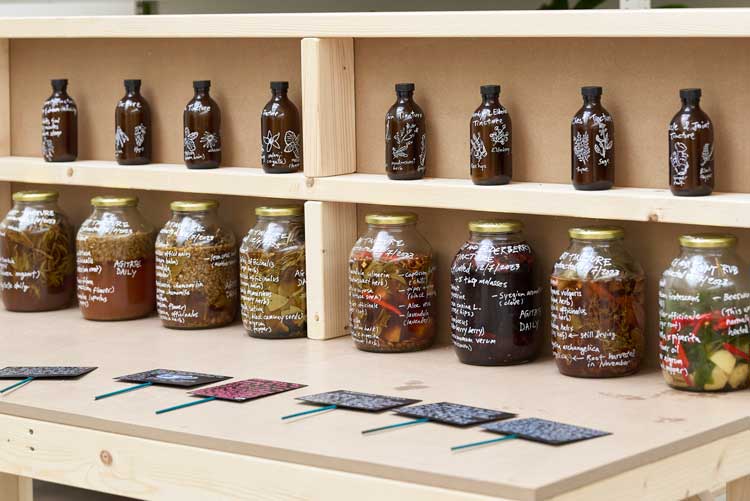
Michael Rakowitz: The Waiting Gardens of the North, an IWM 14-18 NOW Legacy Fund commission in partnership with Baltic Centre for Contemporary Art. Photo: John McKenzie. © 2023 Baltic.
Rakowitz likes to use food, feasting and sharing in his installations and, although Baltic was unable to install a fully operational kitchen in this space, there is a microwave and evidence, on my visit, of food processing – Kilner jars filled with preserved citrus fruit, or red cabbage and apple kraut, the recipes for them written clearly on labels stuck to the glass. The urge to share, to commune, is writ large in these instructions, in the open, accessible orientation of work surfaces, and the placement along their edges of recipe and gardening books as a resource. Large tables nearby invite people to sit and read, chat and spend time here, whether or not they are participating in the multiple workshops. And the scent that fills the room is remarkable. Rosemary dominates, but it is a heady mix of many influences, depending on humidity, sunshine and the time of day as well as surrounding activities.
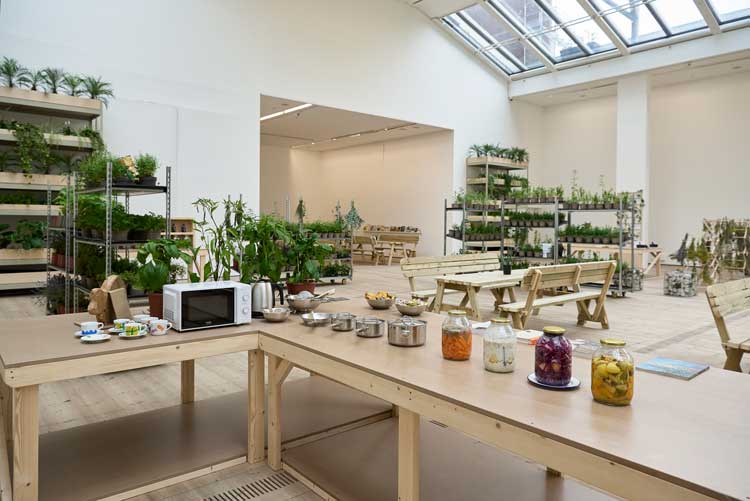
Michael Rakowitz: The Waiting Gardens of the North, an IWM 14-18 NOW Legacy Fund commission in partnership with Baltic Centre for Contemporary Art. Photo: John McKenzie. © 2023 Baltic.
Not only is this work about the life in these planters, and their life in the room – as ingredients for socially and physically nourishing activities - but also the histories of these plants, which are revealed on small, handwritten labels protruding from the sandy beds. “Amaranth was a staple food, medicine, and ritual plant of the Aztecs before Spanish colonisation,” says one. “It can be found on every continent except Antarctica. This wide distribution makes it one of many plants providing evidence of pre-Colombian trans-oceanic exchange.” Some are more succinct: a plant with a furry surface that is commonly found in the UK is simply labelled: “Lamb’s Ear, Nature’s Bandage. Absorbed blood from war-wounded soldiers.” When I check the Latin name for it, I am delighted to see its migratory links revealed – Stachys byzantina. I remember fondling its leaves as a child, and smile when I see an elderly man surreptitiously stroking one furry ear between his fingertips.
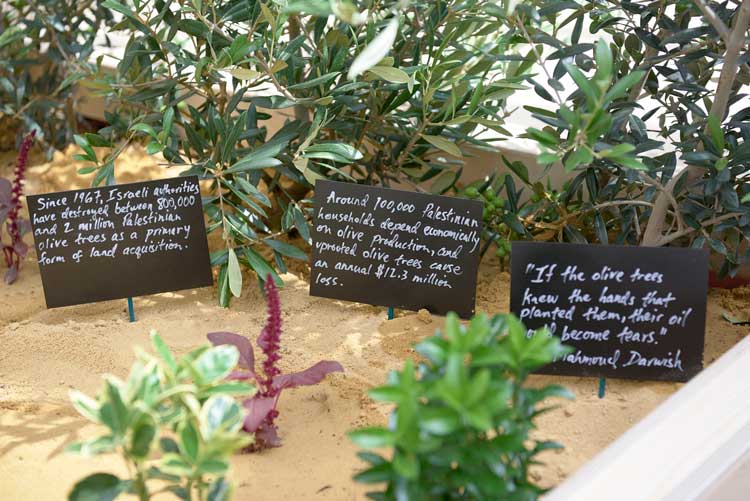
Michael Rakowitz: The Waiting Gardens of the North, an IWM 14-18 NOW Legacy Fund commission in partnership with Baltic Centre for Contemporary Art. Photo: John McKenzie. © 2023 Baltic.
Some histories are far more disturbing, such as one that appears in a planter filled with olive saplings. “Since 1967, Israeli authorities have destroyed between 800,000 and 2m Palestinian olive trees as a primary form of land acquisition,” reads one label. Another tells us: “Around 100,000 Palestinian households depend economically on olive production, and uprooted olive trees cause an annual $12.3m loss.” A third label offers a quote from the Palestinian poet Mahmoud Darwish: “If the olive trees knew the hands that planted them, their oil would become tears.” Does their living presence here, in this generous and social environment, make that knowledge easier to absorb? Does the herb-scented and sociable setting perhaps offer some small balm to these human horrors?
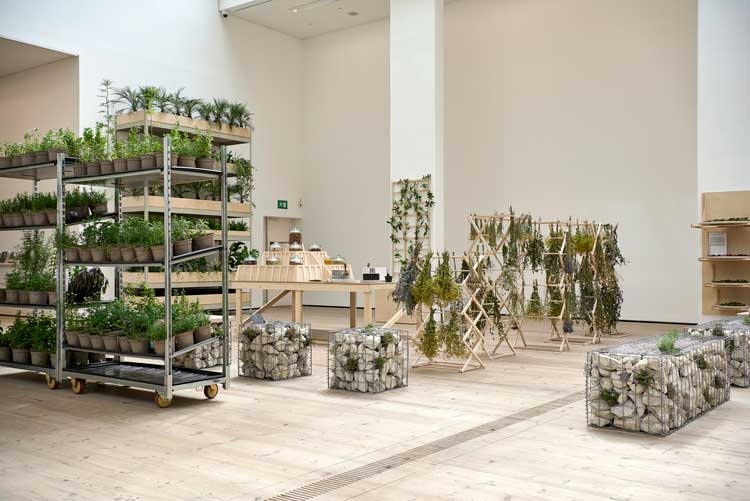
Michael Rakowitz: The Waiting Gardens of the North, an IWM 14-18 NOW Legacy Fund commission in partnership with Baltic Centre for Contemporary Art. Photo: John McKenzie. © 2023 Baltic.
There is a delightfully informal, improvisational quality to the workshop areas. For example, wooden laundry racks have been co-opted as drying racks for bundles of herbs already harvested (whether from here or elsewhere is not stated). Large, granite pestle and mortars await the spice-grinding hour, alongside Kilner jars of ingredients stacked around a timber recreation of some ancient temple.
Rakowitz’s relief panel glows benignly over all this activity, a precise, collaged copy of the original, transforming snippets of Arabic text into mosaic paving, translating vibrant logos of tropical trees taken from packaging into orchards. From the viewing terrace above this room (closed on the day of my visit), you can look down on this relief and see how accurately the surrounding planters recreate its architecture – imaginatively replacing the water seen in the aqueduct that curves around the edge of the palace with blue-flowering plants.
Where Hinterlands, which opened at the Baltic last October and ran until April, revealed the organisation’s rich connections within the local artistic ecosystem, Waiting Gardens required activation of a different part of Newcastle’s and the Baltic’s ecology - namely organisations that promote horticultural knowledge and work with people seeking sanctuary. These include The Comfrey Project, West End Refugee Service, Scotswood Garden, Dilston Physic Garden and Herb Hub.
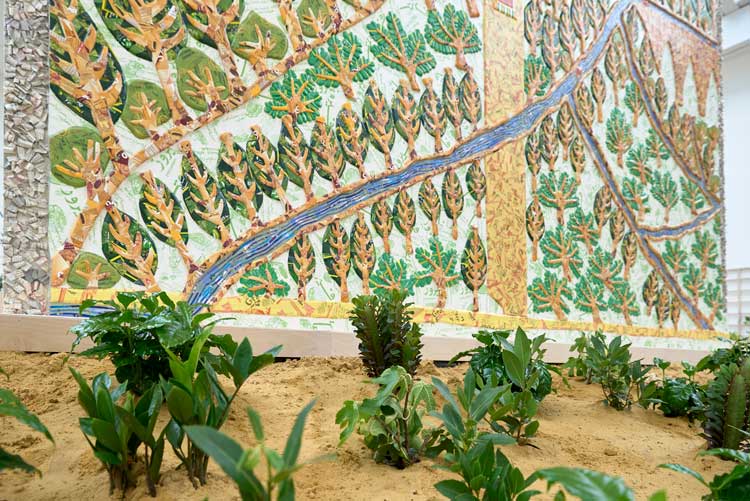
Michael Rakowitz: The Waiting Gardens of the North, an IWM 14-18 NOW Legacy Fund commission in partnership with Baltic Centre for Contemporary Art. Photo: John McKenzie. © 2023 Baltic.
The exhibition’s garden design and maintenance was developed in collaboration with National Trust gardeners at Wallington and Seaton Delaval Hall. The regular involvement of one of their gardeners has been vital, Irene Aristizábal, Baltic’s head of curatorial and public practice, tells me. “Michael is not a gardener. We are not gardeners,” she says. “We were really nervous about how the plants would grow here but they have done much better than I expected.” A changeover of some of the plants is due at the end of September, replacing the more warm-weather or fragile items with those that can survive the colder months.
As for the audience, Aristizábal is confident that the exhibition has achieved its aim to expand the range of visitors, reaching those local residents who are most impacted by these issues. “Through the whole of this exhibition we are collaborating with migrant and refugee communities who are either invisible or not made welcome,” she says. “It’s really important to invite them to be welcome here. And they are definitely coming here, and also spending time.”
Aristizábal assures me that the plants purchased for this installation will be reused, reloved, ideally within the community garden networks of Newcastle. They will filter into this gritty industrial city’s green spaces, just as she hopes the conversations and friendships built up through this ambitious, outward-reaching work, and its workshop programme will enrich the city’s social ecosystem.